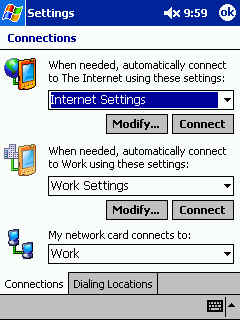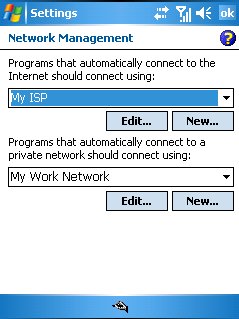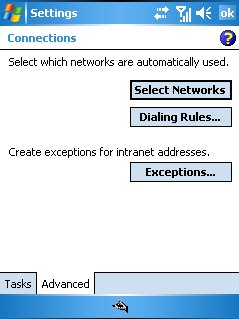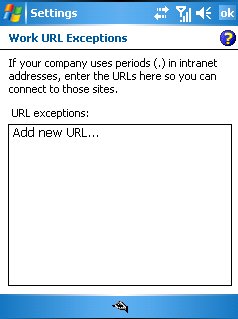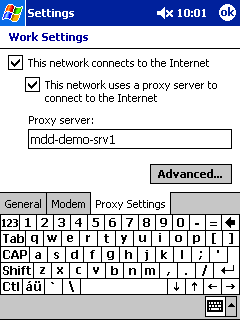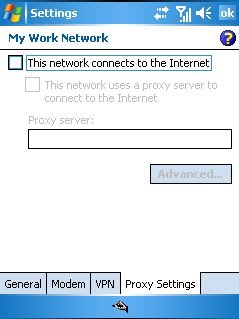|
|
Chris De Herrera's Windows CE Website |
|---|---|
About |
|
| By Chris De Herrera Copyright 1998-2007 All Rights Reserved A member of the Talksites Family of Websites Windows and
Windows CE are trademarks of
Microsoft All Trademarks are owned |
Connection Manager FAQ
By Chris
De Herrera, Copyright 2001, 2006, 2009
Version 1.03 Revised 3/19/2009
[an error occurred while processing this directive]
Introduction
When you start to setup communications on the Pocket PC 2002, Windows Mobile 2003, Windows Mobile 2003 SE or Windows Mobile 5.0 and Windows Mobile 6.x you'll notice that there's a new application called Connection Manager (in Windows Mobile 5.0 this is called Network Management). Connection Manager is Microsoft's way to organize and automate network connections. This FAQ will describe what Connection Manager does and how it works.
Connection Manager Concept
Microsoft created the Connection Manager to automatically route requests to an internal network (intranet) or VPN if the host name does not have a period in it. Also, the Connection Manager supports the ability to use a proxy server to provide access to the internet. Normally the use of a proxy server is for enterprise customers.
Main Options In Connection Manager
There are three drop down boxes that are listed on the main Connection Manager screen. The first one defines what an application will connect to when you need information that is on the internet. IE: Using Pocket Internet Explorer and you enter http://www.pocketpcfaq.com/pocketpc/ which is the Pocket PC version of Pocket PC FAQ. See the images below.
The second drop down box defines where to connect when you request local resources internal to your company (intranet). For example, using Pocket Internet Explorer http://server/ which would display the local web page for the machine named server on your network.
The third drop down box defines where your network card (Ethernet or 802.11b) connects to. So if you choose The Internet, it works the same as drop down number one. If you choose Work, it works the same as the drop down number two as I described above.
|
|
|
|
Pocket PC 2002 |
Windows Mobile 5.0 |
Types of Connections
Connection Manager offers two types of connections - The Internet and Work. These are used for specific reasons depending on the features you need in your connections. Here is a table of the functions and what option to choose:
| Function | The Internet | Work |
| Internet Access | Allows for direct internet access | Requires the user to check the option that the connection allows internet access. |
| Proxy Server | Does not support a proxy server | Supports a proxy server |
| Socks or Winsock Support | Does not support Socks or Winsock | Supports Socks or Winsock for internet access |
| Virtual Private Network (VPN) | Does not support a VPN | Supports a VPN to access the intranet, only when selected in the second list box. |
| Network Synchronization with ActiveSync | Does not support network synchronization | Supports network synchronization (Requires ActiveSync 3.x only. Except Windows Mobile 5.0 devices) |
| Host Access | Names with periods in them (DNS style or FQDN) on the internet | Names without periods in them (WINS style) on the intranet |
You can always add your own type of connection such as when you need to connect to different companies networks.
Applications that Support the Proxy Server Setting
The following applications support the proxy server setting in the Connection Manager:
- Pocket Internet Explorer
- MSN Messenger
The applications that does not use the proxy server settings in the Connection Manager are Windows Media Player and Microsoft Money. So make sure you configure it separately if you want to use Windows Media Player or Microsoft Money through the proxy.
VPN Support
The concept behind the VPN support is that whenever you need to connect to a host without a period in it's name and you have enabled a VPN connection and you are not connected directly to your network, the VPN connection will automatically be started. This occurs when you access a network share, Exchange Server, or a Proxy Server (IE: any host without a period in the name). Also, if you leave the VPN settings blank, the system will not attempt a VPN connection so you can use the Work settings for dialup or a home connection.
One critical note about VPN connections are that they are only opened when a request to a host without a period is made and you are not on the same subnet as the host. Further the VPN is closed when a request is made to the internet. So the VPN connection does NOT support a split horizon.
Further the VPN that is provided with MDM is continually connected. It still uses these rules to direct traffic to the internet.
Exceptions for Hosts with Periods in Name
If you are using a Windows Mobile 5.0 or later device you can specify exceptions to the rules for hosts with a period that are within your network.
|
|
|
|
New option to specify exceptions |
List of Exceptions |
Also, you should be aware that there are two sets of exceptions:
1. Exceptions that are configure administratively using configuration XML. These are not visible to the user in this dialog box. Some device management systems use this function to configure exceptions that the user cannot remove.
2. Exceptions that are typed in the dialog box. The user can edit or remove these exceptions
Example URL Exceptions
| Example URL | Redirects to Internal Network | |
| *://www.contoso.com/* | http and https traffic for any page on www.contoso.com | |
| *://*.contoso.com/* | Any host in contoso.com | |
| *://*.*/* | Any host for any domain using any protocol | |
| http://www.contos.com/index.htm | Only the page www.contoso.com/index.htm using http is accessible | |
| Rules are processed from most restrictive to least restrictive | ||
| For details see Microsoft's Connection URL Mapping | ||
Recommendations
I recommend that users consider just configuring all their connections under Work. That way they can connect to the internet, use a proxy server and access local resources without having to think about these settings. To do this you need to check the box under Proxy Settings that this "This Network Connects to the Internet". Make sure you only check the option to use a proxy if you need it.
By configuring your connections this way, you can use a proxy at home and still get connected to the internet as needed. Also, this will allow you to use any connection you have defined under Work to connect to your VPN as well. If you need access to two networks, then I suggest adding an additional type of setting for the second network. This is done by clicking on the drop down box under the option for Work and selecting NEW. Then you can configure all the same settings for the connection as the default Work connection supports.
|
|
|
|
Pocket PC 2002 |
Windows Mobile 5.0 |
Connection Scenarios that are Not Supported
After reviewing the functionality of the Connection Manager, I have identified the follow scenarios where Connection Manager will not provide you with seamless connectivity:
- Any company that uses a DNS internally will not be able to access
full DNS named hosts internally. This is due to the design that
requests for all names with periods to go to the internet (drop down
number one), not the Work connection (drop down number two) which is
where Work points to. I know that major corporations with internal DNS
based names will have this problem for example. There is no option to
connect to both hosts via the same connection. The user has to switch
between Work and The Internet in drop down box number one to get to
those resources.
Except with Windows Mobile 5.0 devices. There is an option in the Connection Manager to specify DNS named hosts that are internal. See above. - Any user or ISP that uses a proxy and still connects directly to the internet will not work. The proxy assumes all connections with a dot in the name go to the proxy and that the proxy supports socks or winsock to connect. So company's that use a proxy to speed up access to the internet like when you use wireless will experience issues with e-mail due to this issue. So with the connection to Work, you can get to the web but no other service. So if you set it to The Internet then you can get e-mail but no web.
The workaround to access e-mail is to use the IP address of the e-mail server instead of the host name in configuring the mail connection. Also, this will work for web servers as well for their default home page. By using the IP address the system will always get to the host regardless of the connection.
What's Missing?
Apparently, Microsoft did not plan for common issues that users will experience when using connectivity. Microsoft really needs to clarify why users need two different default connections - Work and The Internet. Further the ability to configure the connections for all possible options is very cumbersome. Microsoft needs to really work on making this experience much easier for the user.
Related Articles
Troubleshooting Network Connections
Troubleshooting Dialup Connections
Network Utilities
[an error occurred while processing this directive]



